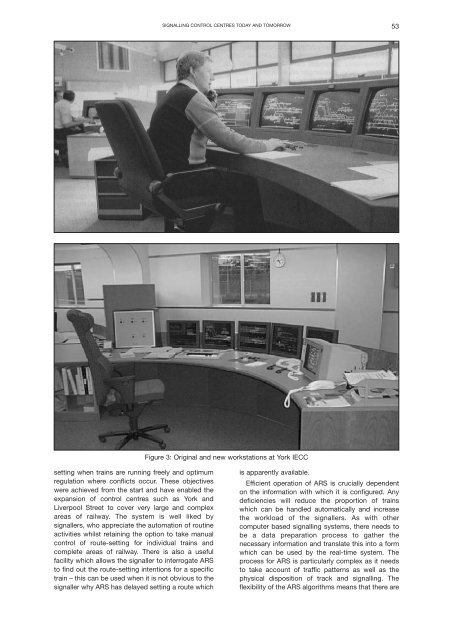Proceedings 2002/2003 - IRSE
Proceedings 2002/2003 - IRSE
Proceedings 2002/2003 - IRSE
You also want an ePaper? Increase the reach of your titles
YUMPU automatically turns print PDFs into web optimized ePapers that Google loves.
SIGNALLING CONTROL CENTRES TODAY AND TOMORROW 53<br />
Figure 3: Original and new workstations at York IECC<br />
setting when trains are running freely and optimum<br />
regulation where conflicts occur. These objectives<br />
were achieved from the start and have enabled the<br />
expansion of control centres such as York and<br />
Liverpool Street to cover very large and complex<br />
areas of railway. The system is well liked by<br />
signallers, who appreciate the automation of routine<br />
activities whilst retaining the option to take manual<br />
control of route-setting for individual trains and<br />
complete areas of railway. There is also a useful<br />
facility which allows the signaller to interrogate ARS<br />
to find out the route-setting intentions for a specific<br />
train – this can be used when it is not obvious to the<br />
signaller why ARS has delayed setting a route which<br />
is apparently available.<br />
Efficient operation of ARS is crucially dependent<br />
on the information with which it is configured. Any<br />
deficiencies will reduce the proportion of trains<br />
which can be handled automatically and increase<br />
the workload of the signallers. As with other<br />
computer based signalling systems, there needs to<br />
be a data preparation process to gather the<br />
necessary information and translate this into a form<br />
which can be used by the real-time system. The<br />
process for ARS is particularly complex as it needs<br />
to take account of traffic patterns as well as the<br />
physical disposition of track and signalling. The<br />
flexibility of the ARS algorithms means that there are

















